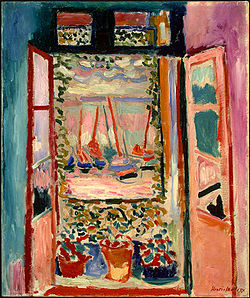| The Open Window | |
|---|---|
 | |
| Artist | Henri Matisse |
| Year | 1905 |
| Medium | Oil on canvas |
| Movement | Fauvism |
| Dimensions | 55.3 cm × 46 cm (21+3⁄4 in × 18+1⁄8 in) |
| Location | National Gallery of Art, Washington D.C. |
The Open Window, also known as Open Window, Collioure, is a painting by Henri Matisse. The work, an oil on canvas, was painted in 1905 and exhibited at the Salon d'Automne in Paris the same year. It was bequeathed in 1998 by the estate of Mrs. John Hay Whitney to the National Gallery of Art, Washington, DC.[1]
It is an example of the Fauvist style of painting that Matisse became famous for, and for which he was a leader, roughly between the years 1900–1909.[2] The Open Window depicts the view out the window of his apartment in Collioure, on the Southern coast of France. We see sailboats on the water, as viewed from Matisse's hotel window overlooking the harbour. He returned frequently to the theme of the open window in Paris and especially during the years in Nice and Etretat, and in his final years, particularly during the late 1940s.
Henri Matisse loved painting open windows and painted them throughout his career.[3]
See also
[edit]References
[edit]- ^ Image and text, National Gallery of Art, retrieved December 25, 2007
- ^ Jack D. Flam, Matisse on Art, paperback edition, 1978, E. P. Dutton, p.10, ISBN 0-525-47490-0
- ^ Gottlieb, Carla (1964). "The Role of the Window in the Art of Matisse". The Journal of Aesthetics and Art Criticism. 22 (4): 393–423. doi:10.2307/427933. JSTOR 427933. Retrieved 12 February 2022.

Well, that’s interesting to know that Psilotum nudum are known as whisk ferns. Psilotum nudum is the commoner species of the two. While the P. flaccidum is a rare species and is found in the tropical islands. Both the species are usually epiphytic in habit and grow upon tree ferns. These species may also be terrestrial and grow in humus or in the crevices of the rocks.
View the detailed Guide of Psilotum nudum: Detailed Study Of Psilotum Nudum (Whisk Fern), Classification, Anatomy, Reproduction